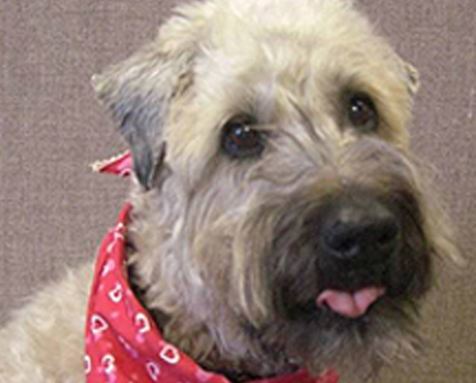
From Emergency Services to Fit and Happy
Duffy is a Wheaten Terrier that presented to our emergency service in March 2011 with a history of vomiting. He was examined by Dr. Fran Heckscher, one of our Emergency Doctors and an abdominal ultrasound was recommended. The ultrasound showed an advanced biliary mucocele. This is an abnormal accumulation of mucus within the gallbladder that can obstruct the flow of bile and ultimately lead to rupture of the gallbladder. In Duffy’s case the ultrasound showed free fluid in the abdomen that led us to believe that his gallbladder had ruptured.
Duffy was taken into the operating room. When Dr. Jacqui Niles opened up his abdomen there was a large amount of bile stained fluid and gelatinous chunks of bile floating free in the abdomen. The gall bladder was enlarged and bile could be seen coming from deep down below the gallbladder. As the surgery progressed, a one cm long tear was found in the common bile duct. Dogs can function normally without their gallbladder but they have to have an intact common bile duct to allow bile that is made in the liver to flow into the intestines. Surgical repair of the bile duct is very difficult due to its small size (approximately 4 mm diameter), poor healing and high incidence of leaking.
The gallbladder was removed, and the rupture of the bile duct was repaired with very fine suture material. Two drain tubes were placed in the abdomen to allow further drainage of bile contaminated fluid from the abdomen.
Over the next few days Duffy developed acute pancreatitis and started losing weight. Pancreatitis is inflammation of the pancreas and causes vomiting, weakness and marked abdominal pain. Duffy’s blood albumin level was also dropping. Albumin is a protein that plays several vital roles in the body and if the levels drop too far, fluid can leak from the blood vessels into the tissues, most dangerously into the lungs causing trouble breathing. Duffy’s condition was becoming critical. To help build up Duffy’s albumin level a feeding tube was placed endoscopically by Dr. John DeBiasio and Duffy was fed a liquid diet via the tube. Despite this, his albumin level kept dropping and he was given a human albumin transfusion.
Duffy’s owners Judy and Bruce visited Duffy frequently, and brought Duffy home cooked, low fat meals to try to tempt him to eat. Slowly Duffy’s pancreatitis began to resolve and his condition began to improve. He started eating some chicken by himself and finally he was discharged on 4/8/11, 16 days after he was admitted to Metropolitan.
Duffy is a remarkable dog with fantastic, loving owners. Thanks to his remarkable personality, the dedication of his owners and the combined skills of the doctors at Metropolitan, Duffy is now fit and happy and regularly sends cards and photos to Metropolitan.
2/14/2013 Update from Duffy:
“Dr. Niles, Valentine’s kisses to you from us and Duffy! He is doing great! Love you so much …”